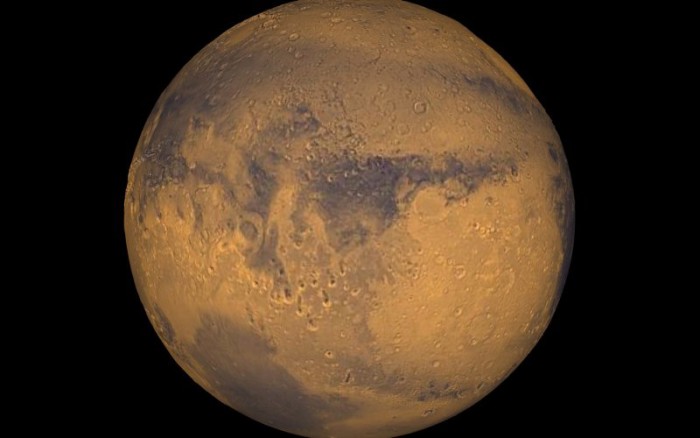NASA found evidence of liquid water on the Red Planet, which means there is the potential for life beyond Earth.

We seem to discover water on Mars about once a year. Well, that’s not quite true: We’ve known Mars has water for quite a while. However, there are a lot of mysteries still to solve about how that water behaves and where it’s located. In particular, we’d like to know if water sometimes flows on the surface of the planet, which would tell us a lot about the cycles both above and below ground. And of course water is essential for life as we know it – finding flowing water, even transient flows, would make Mars seem a little more Earth-like.
The problem is that any liquid water evaporates quickly in the bone-dry Martian desert, and other processes can leave traces that mimic dried-up flows. When so little water is involved in the first place, it leaves us looking for the Martian equivalent of water spots on a long-dry drinking glass. And those spots are chemical traces – salt and other minerals once dissolved in the water – which must be identified by robotic spacecraft from orbit.
Today, scientists using NASA’s Mars Reconnaissance Orbiter (MRO) have identified some of those traces: A little bit of water comes and goes on Mars’ surface. The streaks of material the researchers observed grew slightly during each Martian summer, indicating they might be the result of water flowing or seeping out when the temperatures are high enough. The answer came from using the spectrum of light reflected and absorbed by the material, which turned out to be salts with traces of water left in them.
Similar behaviour in Earth’s Atacama Desert in Chile provides a habitat for some hardy microscopic organisms. If there’s life under the surface of Mars, these temporary flows of water could be a place they occasionally show up aboveground. Unfortunately the dried-up flows are high on crater walls, so none of them are easily accessible to rovers like Curiosity.
Mars is drier than the driest desert on Earth: It has no lakes, oceans, or rivers, and its atmosphere has at best tiny traces of water vapour. However, Mars used to be much wetter. We can see signs of long-gone lakes and riverbeds, though it’s unlikely the planet was ever warm enough to be a lush, damp place like Earth is. The disappearance of Mars’ surface water is one of the mysteries we still have to solve.
However, we’ve suspected water can sometimes flow on Mars for a while. The various orbiting Mars-mapping probes have spotted small landslides along slopes that appeared between orbital passes, which could be caused by water, but are more likely to be the result of more boring geological processes.
The new paper, published today in Nature Geoscience, is based on another intriguing phenomenon. Some slopes at the edges of old craters show streaks of material that reflect much less light than their surroundings. These streaks – known as “recurring slope lineae” or RSL – appear during relatively warm Martian weather and fade as the weather cools off, changing size and shape from year to year. That sort of thing certainly looks like it could be caused by water flowing or seeping out before evaporating again … but we want to be sure.
Martian chemistry helps us there: The soil is full of salts, inorganic chemicals that dissolve easily in water. There are several familiar types of salts: sodium chloride is table salt, magnesium sulphate is Epsom salt, etc. The ones on Mars are more complex: perchlorates (which are based on molecules involving one chlorine and four oxygen atoms) and other combinations. These chemicals absorb light of particular colours, which allowed the authors of the new paper to identify the salts. Better yet: These salts still had traces of water that didn’t evaporate, like if a little moisture gets into the salt shaker and makes the grains stick to each other.
There’s a lot of water under the surface of Mars, but it’s mostly frozen and mingled with other chemicals. For that reason, it’s possible that when the Sun shines and the air is warm enough in the Martian summer, some of that water can melt and flow out. Alternatively, the trace amounts of water in the atmosphere could deliquesce: condense out of the air and stick to minerals on the surface (which already have some water on them), forming salty goo.
Neither idea completely solves the problem of where the water came from. We’ll be hearing more about water on Mars for years to come, including rumours and some hyped-up expectations. Underneath the hype, though, is a steady increase in understanding about where the Martian water is, how much it shaped the surface in the past, and what it might be doing now – and whether life is at all possible.
Courtesy The Daily Beast
